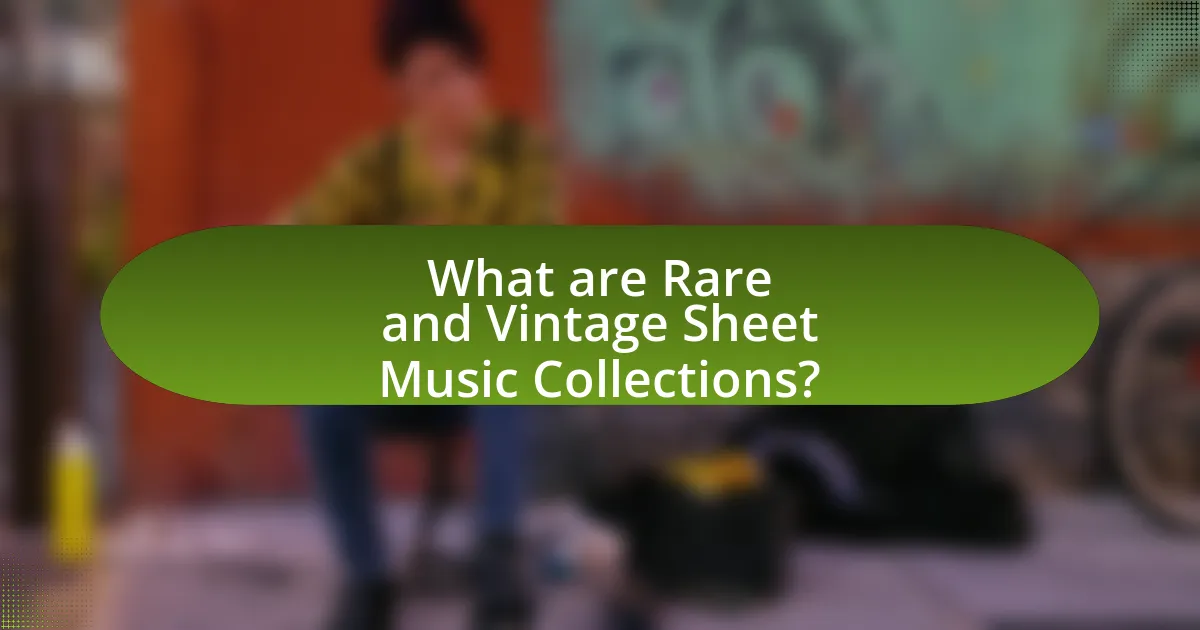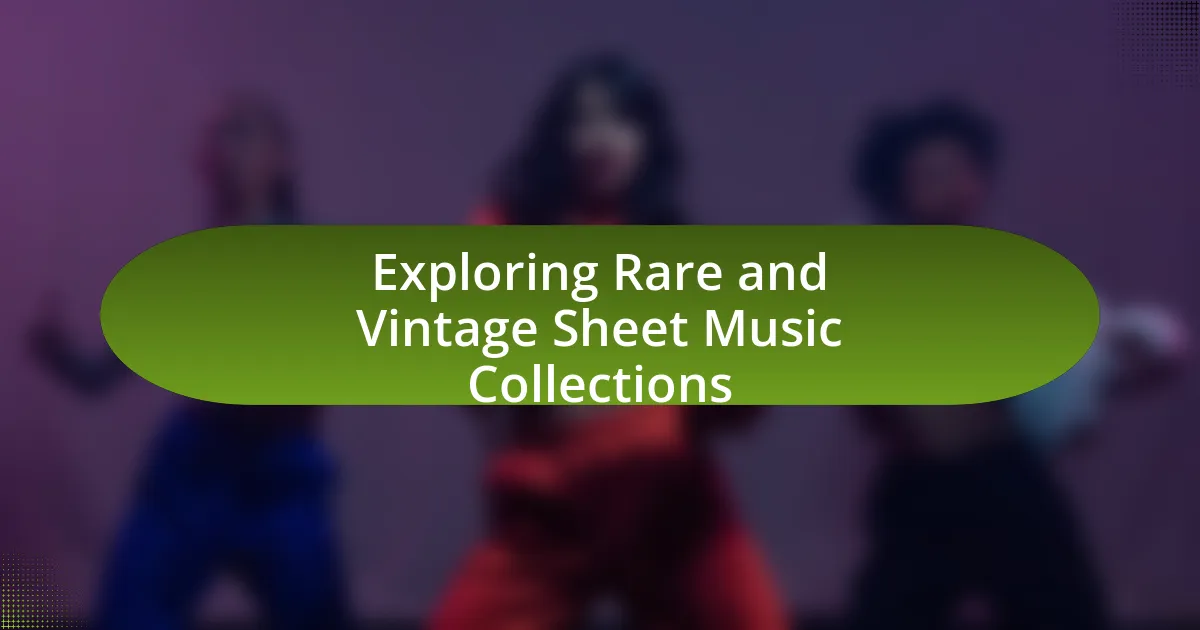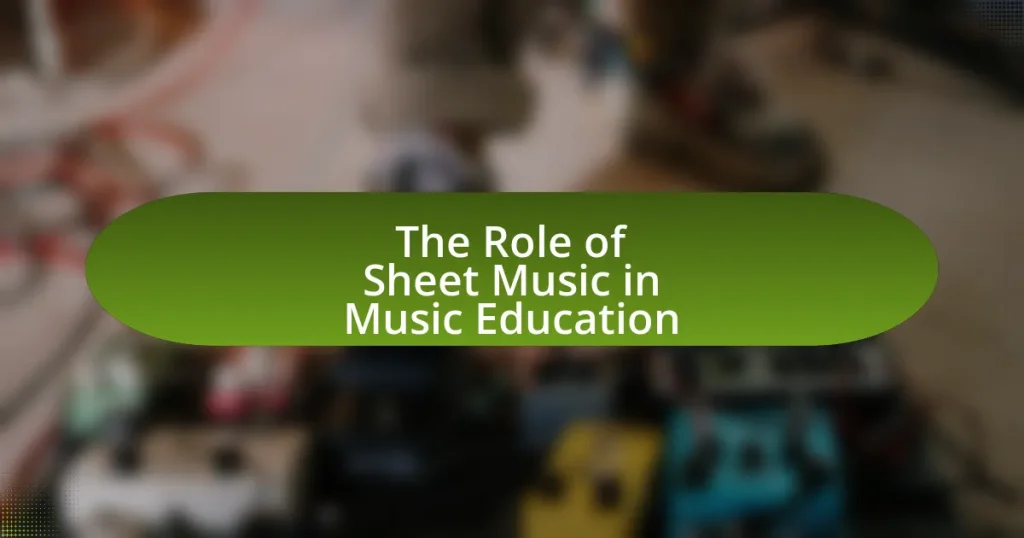Rare and vintage sheet music collections consist of musical scores produced in limited quantities or from earlier historical periods, often dating back to the 19th or early 20th centuries. These collections hold cultural and historical significance, providing insights into musical trends and societal influences. The article explores the criteria for classifying sheet music as rare or vintage, the impact of historical contexts and cultural movements on rarity, and the role of composers in creating collectible works. Additionally, it discusses the emotional and investment value of these collections, the different types of sheet music, and best practices for starting a collection, including tips for avoiding pitfalls and ensuring authenticity.

What are Rare and Vintage Sheet Music Collections?
Rare and vintage sheet music collections are compilations of musical scores that are either produced in limited quantities or are from earlier historical periods, often dating back to the 19th or early 20th centuries. These collections can include works by notable composers, popular songs from specific eras, and unique arrangements that are no longer in print. The significance of these collections lies in their cultural and historical value, as they provide insight into musical trends, societal influences, and the evolution of music over time. Collectors and institutions often seek these items for their rarity, aesthetic appeal, and the potential for scholarly research, making them valuable assets in the field of musicology and cultural heritage.
How do we define rare and vintage sheet music?
Rare and vintage sheet music is defined as musical scores that are either produced in limited quantities or are from a specific historical period, typically over 50 years old. This classification often includes first editions, unique prints, or works by notable composers that are no longer in circulation. For instance, sheet music from the early 20th century, such as pieces by Scott Joplin or George Gershwin, is considered vintage due to its age and cultural significance. The rarity can also be attributed to the condition, provenance, or specific features like autographs, making these items highly sought after by collectors and historians.
What criteria classify sheet music as rare or vintage?
Sheet music is classified as rare or vintage based on several criteria, including age, scarcity, historical significance, and condition. Specifically, sheet music is considered vintage if it is at least 50 years old, while rarity is determined by limited print runs or the absence of copies in circulation. Historical significance can elevate a piece’s status if it is associated with notable composers, performances, or cultural movements. Additionally, the physical condition of the sheet music, including wear and tear, can impact its classification, with well-preserved copies being more desirable. These criteria collectively help collectors and historians identify and value rare or vintage sheet music.
Why is the age of sheet music significant in its classification?
The age of sheet music is significant in its classification because it helps determine the historical context, rarity, and value of the music. Older sheet music often reflects the musical styles, cultural influences, and societal norms of its time, making it a crucial element for collectors and historians. For instance, sheet music from the 19th century may feature different notation practices and compositional styles compared to contemporary works, thus providing insights into the evolution of music. Additionally, age can affect the scarcity of the sheet music; pieces from earlier periods are often less common, increasing their desirability and market value among collectors.
What historical contexts contribute to the rarity of sheet music?
The rarity of sheet music is primarily influenced by historical contexts such as the evolution of music publishing, technological advancements, and cultural shifts. In the 19th century, sheet music was widely produced and distributed, but the advent of recorded music in the 20th century diminished its demand, leading to fewer copies being preserved. Additionally, events like World War II caused significant loss of printed materials, as many were destroyed or discarded. The transition from print to digital formats further contributed to the decline in physical sheet music collections, making surviving pieces increasingly rare.
How do cultural movements influence the creation of rare sheet music?
Cultural movements significantly influence the creation of rare sheet music by shaping the themes, styles, and accessibility of musical compositions. For instance, the Romantic movement in the 19th century emphasized emotional expression, leading composers like Chopin and Liszt to produce unique works that were often published as sheet music, making them collectible. Additionally, the rise of jazz in the early 20th century fostered a new genre of sheet music that reflected the cultural zeitgeist, with pieces like “Maple Leaf Rag” by Scott Joplin becoming rare due to their historical significance and limited print runs. These movements not only inspire composers but also affect the market dynamics, as sheet music tied to specific cultural phenomena often becomes sought after by collectors and historians, thus increasing its rarity.
What role do composers and artists play in the rarity of sheet music?
Composers and artists significantly influence the rarity of sheet music through their creative output and publication choices. When composers produce limited editions or choose not to publish their works widely, the resulting sheet music becomes scarce. For instance, many classical composers, such as Frédéric Chopin, only published a select number of pieces, leading to a limited availability of their sheet music. Additionally, artists who create unique arrangements or original compositions may opt for exclusive distribution, further contributing to the rarity. The combination of selective publication and the unique nature of artistic works creates a market where certain sheet music becomes highly sought after by collectors and musicians alike.
Why are collectors interested in rare and vintage sheet music?
Collectors are interested in rare and vintage sheet music primarily due to its historical significance and cultural value. This type of sheet music often represents important musical eras, showcasing compositions that have shaped genres and influenced artists. For instance, sheet music from the early 20th century can provide insights into the popular music trends of that time, reflecting societal changes and artistic movements. Additionally, collectors value the uniqueness and scarcity of these items, as limited print runs or specific editions can make certain pieces highly sought after. The rarity of such sheet music can also lead to increased monetary value, making it an appealing investment for collectors.
What emotional or nostalgic value does vintage sheet music hold for collectors?
Vintage sheet music holds significant emotional and nostalgic value for collectors as it serves as a tangible connection to the past, evoking memories of personal experiences and cultural moments. Collectors often cherish these pieces for their historical context, as they reflect the musical trends and societal sentiments of their respective eras. For instance, sheet music from the early 20th century can remind individuals of family gatherings or popular songs that shaped their childhoods. Additionally, the artistry of vintage sheet music covers, which often feature intricate designs and illustrations, adds to their aesthetic appeal and emotional resonance. This combination of personal and cultural significance makes vintage sheet music a cherished collectible among enthusiasts.
How does the investment potential of rare sheet music attract collectors?
The investment potential of rare sheet music attracts collectors due to its ability to appreciate in value over time, similar to other collectibles like art or vintage instruments. Collectors recognize that certain pieces, especially those linked to iconic composers or historical significance, can command high prices at auctions; for instance, a rare manuscript by Beethoven sold for over $200,000. This potential for financial return motivates collectors to seek out unique and limited editions, as the rarity often correlates with increased demand and market value. Additionally, the emotional connection to music and nostalgia enhances the desirability, making rare sheet music not only a financial investment but also a personal one.

What are the Different Types of Rare and Vintage Sheet Music?
The different types of rare and vintage sheet music include classical compositions, popular songs from specific eras, jazz standards, and unique arrangements or editions. Classical compositions often feature works by renowned composers like Beethoven or Mozart, while popular songs may originate from the early 20th century, reflecting cultural trends of the time. Jazz standards, such as those by Duke Ellington or Louis Armstrong, represent significant contributions to American music history. Unique arrangements or limited editions can include autographed copies or those published in small runs, making them particularly valuable to collectors. Collectors often seek these types due to their historical significance and cultural impact, which can enhance their value in the market.
What categories exist within rare and vintage sheet music collections?
Rare and vintage sheet music collections typically exist within several categories, including classical, popular music, jazz, folk, and film scores. Classical sheet music often features works by composers such as Beethoven and Mozart, while popular music includes hits from various decades. Jazz collections may contain arrangements from iconic artists like Duke Ellington and Louis Armstrong. Folk music often reflects cultural traditions, and film scores encompass music composed for movies, showcasing the evolution of cinematic soundtracks. Each category represents a distinct genre, contributing to the rich tapestry of music history and offering collectors a diverse range of materials.
How do classical, jazz, and popular music genres differ in rarity?
Classical music is generally rarer than jazz and popular music genres due to its historical significance and the limited number of compositions that have achieved widespread recognition. Classical compositions, particularly those from renowned composers like Bach, Beethoven, and Mozart, are often preserved in specialized collections and are less frequently reproduced in mass markets compared to popular music. Jazz, while also having rare pieces, tends to have a broader range of recordings and performances that are more accessible, making it less rare overall. Popular music, characterized by its mass appeal and commercial production, is the least rare, with countless songs and artists producing new material continuously, leading to a vast availability of sheet music. This distinction in rarity is supported by the fact that classical music often requires specific performance skills and is less frequently performed in casual settings, whereas jazz and popular music are more commonly played and distributed.
What are the characteristics of collectible sheet music from different eras?
Collectible sheet music from different eras exhibits distinct characteristics that reflect the cultural and musical trends of their time. For instance, sheet music from the late 19th century often features ornate cover art and elaborate typography, indicative of the Victorian aesthetic, while the early 20th century saw a shift towards simpler designs that emphasized popular music genres like ragtime and jazz.
In the 1920s and 1930s, the rise of the Tin Pan Alley era introduced vibrant, colorful covers and catchy titles, appealing to a broader audience. The post-World War II period marked a transition to more modern designs, with a focus on rock and roll, featuring bold graphics and photographs of artists.
Additionally, collectible sheet music often includes historical context, such as the popularity of specific songs or composers, which can enhance its value. For example, sheet music from the Great American Songbook is highly sought after due to its cultural significance and the enduring popularity of its songs.
Overall, the characteristics of collectible sheet music vary significantly across eras, reflecting changes in artistic styles, musical genres, and societal influences.
What formats of sheet music are considered rare?
Rare formats of sheet music include handwritten manuscripts, early printed editions from the 18th and 19th centuries, and unique arrangements for specific instruments or ensembles that are no longer in common use. Handwritten manuscripts are particularly valuable due to their uniqueness and the historical context they provide, often being one-of-a-kind works by composers. Early printed editions, such as those produced by notable publishers like C.F. Peters or G. Schirmer, can be scarce, especially if they feature works by significant composers like Beethoven or Chopin. Additionally, specialized arrangements, such as those for instruments like the lute or harpsichord, are considered rare due to the decline in their popularity and usage in contemporary music.
How do original prints differ from reprints in terms of value?
Original prints hold significantly higher value than reprints due to their rarity, authenticity, and historical significance. Original prints are typically produced in limited quantities and often feature the artist’s signature or unique characteristics that authenticate their origin, making them more desirable to collectors. In contrast, reprints are mass-produced and lack the same level of uniqueness and provenance, which diminishes their market value. For example, a limited edition original print by a renowned artist can sell for thousands of dollars, while a reprint of the same work may only be worth a fraction of that amount, often under a hundred dollars. This disparity in value is rooted in the art market’s emphasis on authenticity and the historical context of the original works.
What unique features can enhance the rarity of sheet music formats?
Unique features that can enhance the rarity of sheet music formats include limited print runs, unique cover art, and historical significance. Limited print runs create scarcity, making specific editions more sought after; for example, first editions of popular works often command higher prices. Unique cover art can also contribute to rarity, as visually distinctive designs may attract collectors, particularly if they are associated with notable artists or composers. Additionally, sheet music that has historical significance, such as pieces linked to significant cultural events or movements, can be particularly rare and valuable, as evidenced by the high demand for music from the Harlem Renaissance era.
What are some notable examples of rare sheet music collections?
Notable examples of rare sheet music collections include the Library of Congress’s collection, which houses over 1.5 million pieces, featuring works from composers like Beethoven and Gershwin. Another significant collection is the New York Public Library’s Music Division, known for its extensive holdings of American popular music and rare manuscripts. Additionally, the British Library contains a vast array of historical sheet music, including early editions of operas and symphonies. These collections are recognized for their cultural and historical importance, preserving the legacy of music across different eras.
Which collections are recognized as the most valuable in the world?
The most valuable collections in the world include the “Walt Disney Collection,” valued at over $1 billion, and the “The Beatles’ Original Sheet Music Collection,” estimated at around $500 million. The Walt Disney Collection features rare memorabilia and original artwork, while The Beatles’ collection includes first editions of their iconic sheet music, which are highly sought after by collectors. These valuations are supported by auction results and market demand, highlighting their significance in the realm of rare and vintage sheet music.
How do specific pieces of sheet music gain legendary status among collectors?
Specific pieces of sheet music gain legendary status among collectors through a combination of historical significance, rarity, and cultural impact. Historical significance is often derived from the association of the sheet music with iconic artists, landmark performances, or pivotal moments in music history, such as the original publication of “Maple Leaf Rag” by Scott Joplin in 1899, which marked a significant development in ragtime music. Rarity plays a crucial role, as limited print runs or unique editions, like the first pressing of “The Entertainer,” can drive demand and value. Cultural impact is evidenced by how certain pieces resonate with audiences or influence subsequent music genres, such as the enduring popularity of “Over the Rainbow” from “The Wizard of Oz,” which has become a timeless classic. Collectors often seek these pieces not only for their monetary value but also for their emotional and historical connections to the broader narrative of music.

How Can One Start Collecting Rare and Vintage Sheet Music?
To start collecting rare and vintage sheet music, one should first research and identify specific genres or periods of interest, as this focus will guide the collection process. Engaging with online marketplaces, auction sites, and specialized music shops can provide access to a variety of sheet music options. Additionally, attending music fairs, estate sales, and auctions can yield unique finds. Joining collector groups or forums can offer valuable insights and networking opportunities with other enthusiasts. According to the American Musicological Society, understanding the historical context and significance of the pieces can enhance the collecting experience and value of the collection.
What are the best practices for beginning a sheet music collection?
To begin a sheet music collection effectively, start by defining your focus, such as a specific genre, composer, or time period. This targeted approach helps streamline your collection efforts and makes it easier to find relevant pieces. For instance, focusing on classical music from the Romantic era allows you to concentrate on composers like Chopin and Brahms, which can enhance your understanding and appreciation of that style.
Next, establish a budget to guide your purchases, as sheet music can vary significantly in price based on rarity and condition. Allocating funds wisely ensures you can acquire quality pieces without overspending. Additionally, consider utilizing both online and local resources, such as music stores, libraries, and estate sales, to discover a diverse range of sheet music.
Finally, organize your collection systematically, using categories or a cataloging system to keep track of your pieces. This organization facilitates easy access and helps maintain the condition of your music. Following these best practices will create a solid foundation for a meaningful and enjoyable sheet music collection.
How can collectors identify reputable sources for purchasing sheet music?
Collectors can identify reputable sources for purchasing sheet music by researching established music retailers, checking online marketplaces with verified sellers, and consulting reviews from other collectors. Established music retailers often have a long-standing reputation and provide guarantees of authenticity, while online marketplaces like eBay or Etsy feature seller ratings and reviews that can indicate reliability. Additionally, joining collector forums or groups can provide insights and recommendations from experienced collectors, further ensuring that sources are trustworthy.
What tools and resources are available for evaluating sheet music value?
Tools and resources available for evaluating sheet music value include online marketplaces, auction sites, and specialized valuation guides. Online platforms like eBay and Etsy provide insights into current market prices by showcasing completed sales of similar items. Auction houses such as Sotheby’s and Bonhams often feature rare sheet music in their catalogs, offering expert appraisals and historical context. Additionally, valuation guides like “The Music Price Guide” provide comprehensive pricing information based on historical sales data, helping collectors assess the worth of their sheet music. These resources collectively enable accurate evaluations by combining market trends with expert insights.
What common pitfalls should new collectors avoid?
New collectors should avoid overpaying for items, as inflated prices can lead to significant financial loss. Many inexperienced collectors may lack knowledge about market values, resulting in purchases that exceed fair market prices. Researching recent sales of similar items and consulting price guides can help ensure fair pricing. Additionally, collectors should be cautious of buying from unverified sources, as this increases the risk of acquiring counterfeit or misrepresented items. Verifying the authenticity of sheet music through reputable dealers or established marketplaces can mitigate this risk. Lastly, new collectors often overlook the importance of proper storage and handling, which can lead to damage and decreased value over time. Using archival materials and maintaining a controlled environment can preserve the condition of rare and vintage sheet music.
How can one avoid counterfeit or misrepresented sheet music?
To avoid counterfeit or misrepresented sheet music, one should purchase from reputable dealers or established publishers known for their authenticity. Reputable sources often provide provenance or documentation that verifies the sheet music’s legitimacy. Additionally, examining the quality of printing, paper, and binding can help identify genuine items, as authentic sheet music typically exhibits high-quality production standards. Researching the specific edition or print run can also reveal discrepancies, as counterfeit versions may lack unique identifiers present in legitimate copies.
What are the risks of overpaying for rare sheet music?
Overpaying for rare sheet music poses several risks, including financial loss, diminished resale value, and potential for counterfeit items. When collectors pay excessively, they may not recoup their investment if the market value declines or if they wish to sell the item later. For instance, the market for rare sheet music can fluctuate significantly; a piece that is highly sought after today may lose its appeal, leading to a decrease in value. Additionally, the risk of acquiring counterfeit or misrepresented items increases with higher price tags, as sellers may exploit buyers’ enthusiasm for rarity. According to a 2021 study by the International Association of Music Libraries, a significant percentage of collectors reported encountering counterfeit sheet music, highlighting the importance of verifying authenticity before making high-value purchases.
What tips can enhance the collecting experience for enthusiasts?
To enhance the collecting experience for enthusiasts of rare and vintage sheet music, it is essential to focus on organization, research, and community engagement. Organizing collections systematically allows collectors to easily access and appreciate their items, while thorough research on the historical context and value of each piece enriches the collecting journey. Engaging with fellow collectors through forums or local clubs fosters knowledge sharing and networking opportunities, which can lead to discovering rare finds. Collectors should also consider attending specialized fairs and auctions, as these events provide access to unique items and expert insights, further enhancing the overall experience.
How can networking with other collectors benefit one’s collection journey?
Networking with other collectors can significantly enhance one’s collection journey by providing access to shared knowledge, resources, and opportunities for acquiring rare items. Engaging with fellow collectors allows individuals to exchange insights about specific genres, historical contexts, and valuation of sheet music, which can lead to more informed purchasing decisions. Additionally, networking can facilitate connections to exclusive sales, auctions, or trade opportunities that may not be publicly advertised, thereby increasing the chances of obtaining unique pieces. For instance, a study by the American Collectors Association found that 70% of collectors reported acquiring valuable items through connections made within collector communities. This demonstrates that networking is a vital component in expanding and enriching a collection.
What role does preservation play in maintaining the value of sheet music?
Preservation plays a critical role in maintaining the value of sheet music by ensuring its physical integrity and accessibility for future generations. When sheet music is preserved through proper storage, handling, and restoration techniques, it prevents deterioration caused by environmental factors such as humidity, light, and temperature fluctuations. For instance, archival-quality materials and controlled environments can significantly extend the lifespan of sheet music, thereby retaining its historical and monetary value. Additionally, the preservation of sheet music allows for continued scholarly research and performance opportunities, which further enhances its cultural significance and market demand.



